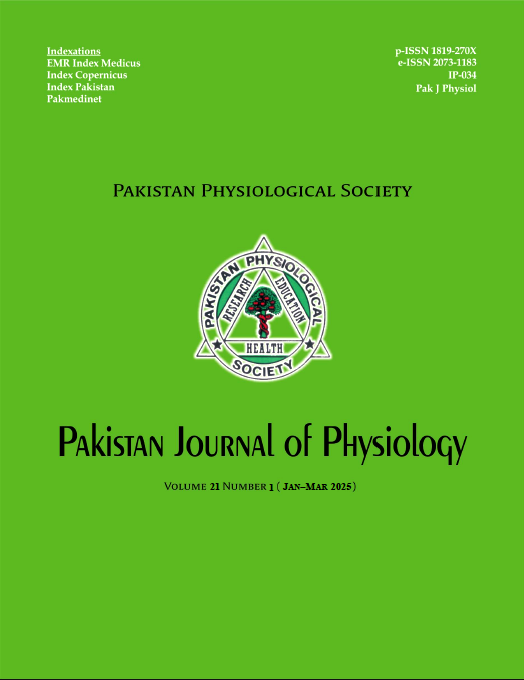NERVE CONDUCTION STUDY PATTERNS IN EARLY GUILLAIN BARRÉ SYNDROME
DOI:
https://doi.org/10.69656/pjp.v21i1.1660Keywords:
Guillain-Barré syndrome, Nerve conduction study, Electrophysiological studiesAbstract
Background: Nerve conduction studies (NCS) in early Guillain-Barré Syndrome (GBS) help differentiate demyelinating from axonal subtypes, though findings may be subtle or normal initially. Objective of this study was to explore the NCS findings in patients presenting with early GBS. Methods: This cross-sectional study was conducted at Department of Physiology, Shaheed Zulfiqar Ali Bhutto Medical University, and Department of Neurology, Pakistan Institute of Medical Sciences, Islamabad from May 2023 to February 2024. Data was collected from 94 patients after written informed consent and analysed using SPSS-23. Chi-square test was applied taking p?0.05 as significant. Results: Twenty-one 21 cases had normal Nerve Conduction Study, 73 NCS cases showed abnormal findings out of which 13.7% cases had normal motor conduction velocities and 86.3% had abnormal conduction velocities. Moreover, 20.5% cases had normal while 79.5% cases had abnormal distal motor latencies; 15.1% cases out of the abnormal NCS cases had normal and 84.9% cases had abnormal F-waves. Out of 74 abnormal NCS, 28.8% had normal compound motor action potential and 71.2% had abnormal compound motor action potential (p=0.0001). There was significant association (p?0.05) between NCS and electrophysiological parameters. Conclusion: GBS is common in 13–65 years age group with male predominance. NCS findings were abnormal in 77.7% of cases presenting early. Early electrophysiological parameters in NCS, elucidate their diagnostic significance and offer insight into pathophysiology of nerve disorders.
Pak J Physiol 2025;21(1):48–51, DOI: https://doi.org/10.69656/pjp.v21i1.1660
Downloads
References
Khalid B, Waqar Z, Khan S, Ali S, Ali I, Tariq M, et al. Exploring the relationship between EGRIS and the need for mechanical ventilation in Guillain Barré Syndrome. Pak J Neurol Sci 2023;18(1):26–31.
Ahn SW, Yoon BN, Kim JE, Seok JM, Kim KK, Lim YM, et al. Korean Society of Clinical Neurophysiology Education Committee. Nerve conduction studies: basic principal and clinical usefulness. Ann Clin Neurophysiol 2018;20(2):71–8.
Alanazy MH, Muayqil T, Aldraihem MO, Alkhawajah NM. Electrodiagnostic reference data for sensory nerve conduction studies in Saudi Arabia. Neurosciences (Riyadh) 2020;25(2):112–22.
Lee EB, Lee YY, Lee JM, Son SM, Hwang SK, Kwon S, et al. Clinical importance of F-waves as a prognostic factor in Guillain-Barré syndrome in children. Korean J Pediatr 2016;59(6):271–5.
Zimnowodzki S, Butrum M, Kimura J, Stålberg E, Mahajan S, Gao L. Emergence of F-waves after repetitive nerve stimulation. Clin Neurophysiol Pract 2020;5:100–3.
Tan CY, Sekiguchi Y, Goh KJ, Kuwabara S, Shahrizaila N. A model to predict the probability of acute inflammatory demyelinating polyneuropathy. Clin Neurophysiol 2020;131(1):63–9.
Yoon BA, Bae JS, Kim JK. Electrognostic findings of Guillain-Barré syndrome. Ann Clin Neurophysiol 2020;22(1):13–8.
Drenthen J, Islam B, Islam Z, Mohammad QD, Maathuis EM, Visser GH, et al. Changes in motor nerve excitability in acute phase Guillain?Barré syndrome. Muscle Nerve 2021;63(4):546–52.
Uncini A, Kuwabara S. The electrodiagnosis of subtypes: where do we stand? Clin Neurophysiol 2018;129(12):2586–93.
Berciano J, Orizaola P, Gallardo E, Pelayo-Negro AL, Sánchez-Juan P, Infante J, et al. Very early Guillain-Barré syndrome: A clinical-electrophysiological and ultrasonographic study. Clin Neurophysiol Pract 2019;5(1):1–9.
Bhargava A, Banakar BF, Pujar GS, Khichar S. A study of Guillain-Barré syndrome with reference to cranial neuropathy and its prognostic implication. J Neurosci Rural Pract 2014;5(Suppl 1):S43–7.
Verboon C, Van Doorn PA, Jacobs BC. Treatment dilemmas in Guillain-Barré syndrome. J Neurol Neurosurg Psychiatry 2017;88(4):346–52.
Hughes RA, Swan AV, Raphaël JC, Annane D, van Koningsveld R, van Doorn PA. Immunotherapy for Guillain-Barré syndrome: a systematic review. Brain 2020;130(Pt 9):2245–57.
Iqbal R, Asad MJ, Shah MB, Mahmood RT, Siddiqi S. Clinical and biochemical profile of Guillain Barré Syndrome in Pakistan. Neurosciences (Riyadh) 2021;26(3):242–7.
ul Haq MA, Nabi D, Khan MO, Ullah R, Junaid M, Nasarullah HM. Frequency, age, gender distribution, and seasonal variation of Guillain-Barré syndrome in a province of Pakistan: a retrospective study: prevalence of Guillain-Barré syndrome. Pak J Health Sci 2023;4(3):207–10.
Brohi H, Kumar R, Mubarak S, Mumtaz MA. Early electrophysiological findings in Guillain-Barré syndrome. Pak J Neurol Sci 2017;12(4):9–14.
Shrirang NP, Anand GJ. Study of electrophysiological findings in Guillain-Barré Syndrome. Pravara Med Rev 2021;13(4):49–57.
Umer SR, Nisa Q, Kumari M, Abbas S, Mahesar SA, Shahbaz NN. Clinical features indicating the need for mechanical ventilation in patients with Guillain Barré syndrome. Cureus 2019;11(8):e5520.
Shang P, Zhu M, Baker M, Feng J, Zhou C, Zhang HL. Mechanical ventilation in Guillain-Barré syndrome. Expert Rev Clin Immunol 2020;16(11):1053–64.
Durand MC, Porcher R, Orlikowski D, Aboab J, Devaux C, Clair B, et al. Clinical and electrophysiological predictors of respiratory failure in Guillain-Barré syndrome: a prospective study. Lancet Neurol 2006;5(12):1021–8.
Patel P, Shah D, Jani C, Shah J, Jani R, Kelaiya A, et al. Outcomes of patients presenting with Guillain-Barré Syndrome at a tertiary care center in India. BMC Neurol 2022;22(1):151.
Sriwastava S, Kataria S, Tandon M, Patel J, Patel R, Jowkar A, et al. Guillain Barré Syndrome and its variants as a manifestation of COVID-19: A systematic review of case reports and case series. J Neurol Sci 2021;420:117263.
Downloads
Published
How to Cite
Issue
Section
License
Copyright (c) 2025 Nayab Aslam, Shemaila Saleem

This work is licensed under a Creative Commons Attribution-NoDerivatives 4.0 International License.
The author(s) retain the copyrights and allow their publication in Pakistan Journal of Physiology, Pak J Physiol, PJP to be FREE for research and academic purposes. It can be downloaded and stored, printed, presented, projected, cited and quoted with full reference of, and acknowledgement to the author(s) and the PJP. The contents are published with an international CC-BY-ND-4.0 License.












